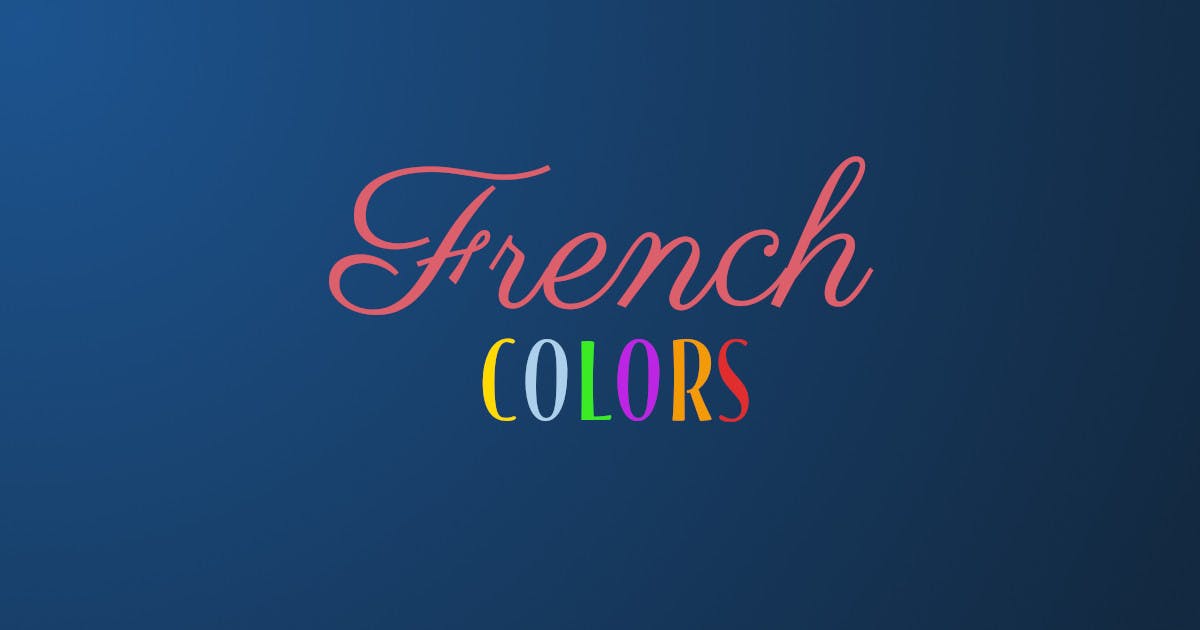How To Say All The Colors In French
As in English, colors in French can be either nouns (e.g., le bleu de ses yeux / the blue of her eyes) or adjectives (e.g. ses yeux bleus / her blue eyes).
The difference is that French color adjectives generally need to agree in number and gender with the words they modify.
The trick is to know when they should agree and when they should remain invariant.
Thankfully, the number of rules to remember is short.
1. Nouns Used as Color Adjectives
In both languages, the nouns for certain objects have come to be used as the names of colors because of their distinctive hue.
One such category of nouns is derived from the names for fruits (e.g. des nappes groseille / redcurrant tablecloths); another from the names for plants/flowers (e.g. les tons lavende / the lavender tones); another from metals (e.g. les reflets bronze / the bronze reflections); yet another from minerals (e.g. les eaux turquoise / the turquoise waters).
The general rule in these instances is that when these nouns are used as adjectives they remain invariant, agreeing neither in gender nor number with the words they modify.
There exists, however, a limited set of nouns which have become variable through usage.
Variable Exceptions: rose(s), mauve(s), fauve(s) / tawny, pourpre(s) /crimson, écarlate(s) / scarlet, incarnat(s) / crimson, vermeille(s) / rose-red
Examples:
Des robes écarlates (Scarlet robes)
Des poupées roses (Rose dolls)
All other invariant color adjectives derived from nouns:
Fruits: abricot / apricot, cerise / cherry, citron / lemon, framboise / raspberry, groseille / redcurrant, orange, pastèque / watermelon, etc…
Plants/Flowers: acajou / mahogany, amarante / amaranth, aubergine /eggplant, café / coffee, coquelicot / poppy, tilleul / lime tree, etc…
Metals: argent / silver, bronze, cuivre / copper, *or / gold, etc…
Minerals: améthyste / amethyst, émeraude / emerald, jade, topaze / topaz, turquoise, etc…
Examples:
Des Porsches cerise (Cherry-red Porsches)
Des teintures acajou (Mahogany dyes)
Des carrosseries argent (Silver car bodies)
Des accents émeraude (Emerald accents)
- Note that just as with the English, the noun of the metal or / gold has an associated adjective doré / golden.
2. Adjectives of Color Used Singly
Adjectives of color used singly agree in gender and number with the words they modify.
Some of these adjectives are: bleu / blue, blanc / white, rouge / red, noir / black, vert / green, gris / grey, jaune / yellow, etc… Also included in this list are the exceptions we saw above.
Examples:
Le vélo bleu – Les vélos bleus (The blue bike – The blue bikes)
La feuille blanche de papier — Les feuilles blanches de papier (The white page of paper — The white pages of paper)
Le feu rouge – Les feux rouges (The red light – The red lights)
3. Adjectives of Color Juxtaposed Next to One Another in a Compound Form
Adjectives in such compound constructs remain invariant, agreeing neither in gender nor number with the words they modify.
The second adjective modifies the quality of the color defined by the first adjective.
In essence, you’re no longer saying light yellow t-shirts but t-shirts of a light yellow.
Examples:
Une chaussette grise – Une chaussette gris clair (A grey sock – A light grey sock)
Les sucettes rouges – Les sucettes rouge bonbon (The red lollipops — The candy red lollipops)
Des murs blancs – Des murs blanc pâle (White walls – Pale white walls)
4. Two Adjectives of Color Separated by And
In these instances, agreement is contingent on the meaning one wishes to convey.
It is possible to consider that:
— the two adjectives constitute a single, compound construct in which case both adjectives remain invariant.
Examples:
L’ardoise noir et blanc (The black and white blackboard)
Des robes rouge et or (Red and gold dresses)
— the two adjectives each embody a distinct qualification in which case both adjectives must agree in gender and number with the words they modify.
Examples:
Des maillots jaunes et beiges (Yellow and beige jerseys)
La foule brune et blonde (The brunette and blond crowd)

SUBSCRIBE: